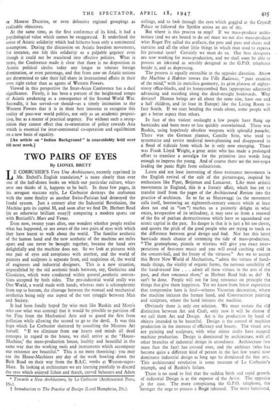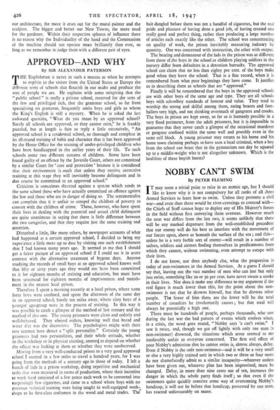TWO PAIRS OF EYES
By LIONEL BRETT
LE CORBUSIER'S Vers Une Architecture, recently reprinted in Mr. Etchell's English translation,* is more clearly than ever one of the half-dozen books on which our particular culture, what- ever one thinks of it, happens to be built. In these few pages, in his arrogant staccato style, Le Corbusier destroys the craftsman with the same finality as another Swiss-Parisian had destroyed the feudal system. Just a century after the Industrial Revolution, the Machine gets its capital M, and soon after we find Dr. Herbert Read (in an otherwise brilliant essay)t comparing a modern sports car with Botticelli's Mars and Venus.
Even now, twenty years after, one wonders whether people realise what has happened, or are aware of the two pairs of eyes with which they have learnt to walk about the world. The familiar aesthetic of the human hand and the new aesthetic of the machine are miles apart and can never be brought together, because the hand errs delightfully and the machine does not. So we look at pictures with one pair of eyes and aeroplanes with another, and the world of painters and sculptors is separate from, and suspicious of, the world of engineers and industrial designers. This is a new situation, unparalleled by •the old aesthetic feuds between, say, Gothicists and Classicists, which were conducted within general ,aesthetic conven- tions accepted by both sides. The pre-industrial world really was One World, a world made with hands, whereas ours is schizophrenic from top to bottom, the cleavage between the manual and mechanical aesthetics being only one aspect of the vast struggle between Man and Society.
It had been fondly hoped (by wise men like Ruskin and Morris who saw what was coming) that it would be possible to partition off the Fine from the Mechanical Arts and to guard the first from pollution while allowing the second to go to the devil. It was this hope which Le Corbusier shattered by assaulting the Mistress Art herself. " If we eliminate from our hearts and minds all dead concepts in regard to the house, we shall arrive at the ' House- Machine,' the mass-production house, healthy and beautiful in the same way that the working tools and instruments which accompany our existence are beautiful." This is no mere theorising: you may see the House-Machines any day of the week bowling down the Bath Road on their way from the B.A.C. works at Weston-super- Mare. In looking at architecture we are learning painfully to discard the eyes which enjoyed lichen and thatch, carved balusters and Adam * Towards a New Architecture, by Le Corbusier (Architectural Press, 15s.).
t Introduction to The Practice of Design (Lund Humphries, 25s.). ceilings, and to look through the eyes which goggled at the Crystal Palace or followed the Spitfire across an arc of sky.
But where is this process to stop? If we mass-produce archi- tecture (and we are bound to do so) must we not also mass-produce what Roger Fry called the artifacts, the pots and pans and chairs and curtains and all the other little things in which man used to express his personal taste? Certainly we must do so. Our best designers are now working for mass-production, and we shall soon be able to possess an inkstand as sensibly designed as the G.P.O. telephone beside it, and as depressing.
The process is equally extensible in the opposite direction. Above the Machine a Habiter towers the Ville Radieuse, " pure creation of the mind," with its merciless geometry, its grim platoon of eighty- storey office-blocks, and its honeycombed flats (appropriate adjective) advancing and receding along the dead-straight boulevards. Why deviate? Human beings are all about the same size, have one and a half children, and (at least in Europe) like the Living Room to face South. If we start bending the roads about, some people will get a better aspect than others.
In face of this violent onslaught a few people have flung up barricades and been more or less quickly overwhelmed. There was Ruskin, using hopelessly obsolete weapons with splendid panache. There was the German planner, Camillo Sitte, who tried to systematise and revive medieval town-planning and disappeared in a flood of ridicule from which he is only now emerging. There was Frank Lloyd Wright, a great artist who has made a prolonged effort to translate a nostalgia for the primitive into words long enough to impress the young. And of course there are the neo-yogis leading the panic flight from collectivism.
Latest and not least interesting of these resistance movements is the English revival of the cult of the picturesque, inspired by enthusiasts like Piper, Betjeman and Lancaster. Like most artistic movements in England, this is a literary affair, which has yet to transfer itself from the pages of the Architectural Review into the practice of architects. In so far as Sharawaggi (as the movement calls itself, borrowing an eighteenth-century conceit which at least does not end in "ism ") teaches us a painterly delight in what exists, irrespective of its orthodoxy, it may save us from a renewal of the fits of puritan destructiveness which have so squandered our scenic capital in the past. Its danger is that it is just a bit too clever,' and queers the pitch of the good people who are trying to teach us the difference between good design and bad. Nor has this latest, barricade much chance of stemming the tide of mass-production. "The gramophone, pianola or wireless will give you exact inter- pretations of first-rate music and you will avoid catching cold in the concert-hall, and the frenzy of the virtuoso." Are we to accept this Brave New World of Mechanism,. " admit the virtues of hand- made things, the vitality of organic forms, the nervous sensibility of the hand-traced line . . . admit all these virtues in the arts of the past, and then renounce them," as Herbert Read bids us do? It can't be done. People will not for long renounce on principle the things that give them happiness. Yet we know from bitter experience that compromise here is fatal—witness Victorian decoration, where the machine imitates the human hand, and Constructivist painting and sculpture, where the hand imitates the machine.
Obviously there is only one solution. We must restate the old distinction between Art and Craft, only now it will be clearer if we call them Art and Design. Art is the production by hand of objects intended to be beautiful. Design is the control of machine production in the interests of efficiency and beauty. The visual arts are painting and sculpture, with what minor crafts have escaped machine production. Design is dominated by architecture, with all other branches of industrial design in attendance. Architecture (we must face the fact) has crossed over, and the architect (who has become quite a different kind of person in the last few years) now dominates industrial design as long ago he dominated the fine arts. This architectural revolution is some measure of Le Corbusier's triumph, and of Ruskin's failure.
There is no need to feel that the sudden birth and rapid growth of industrial Design is at the expense of the Artist. The opposite is the case. The more conspicuous the G.P.O. telephone, the a stronger the urge to possess a Bo* inkstand. The more functional, our architecture, the more it cries out• for the mural painter and the sculptor. The bigger and better our New Towns, the more need for the gardener. Within their respective spheres of influence there is no reason why the Individuality of the hand and the Communism of the machine should not operate more brilliantly than ever, so long as we remember to judge them with a different pair of eyes.



































 Previous page
Previous page